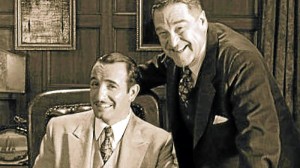Oscar-winning homage to cinema dramatizes changing of the guard
When “The Artist” won Best Picture at the Oscars last month, it became only the second silent film to earn the Academy’s top plum—after William Wellman’s 1927 actioner, “Wings,” won the coveted prize during the first Academy Awards in 1929!
But, the award-giving season that culminated at last month’s Oscars was made even more interesting by the race between provocative movies that reflect the pervading doom and gloom in politics and global economy on one hand and feel-good flicks that allow viewers to temporarily forget their worries on the other.
Mind-benders
The first group was represented by Stephen Daldry’s Oscar-nominated 9/11 drama, “Extremely Loud & Incredibly Close” and a trio of apocalyptic mind-benders: Lars von Trier’s “Melancholia,” Jeff Nichols’ “Take Shelter” and Mike Cahill’s “Another Earth.”
“Melancholia” examines the relationship of two sisters (Kirsten Dunst and Charlotte Gainsbourg) as a mysterious planet threatens to collide with ours. Jeff Nichol’s “Take Shelter” has Michael Shannon building an underground shelter after disturbing visions about the Armageddon haunt him—is his mind just playing tricks on him, or has he gone nuts?
Article continues after this advertisementAnd, in “Another Earth,” as scientists discover a duplicate planet Earth in the solar system, a remorseful student (Brit Marling) crosses paths with the grief-stricken musician (William Mapother) whose wife and son perished in a drunken-driving tragedy she was responsible for!
Article continues after this advertisementOn the other hand, the “sunnier,” other end of the cinematic spectrum vivifies Tinseltown’s self-referential bent this year, led by top Academy Award winners, Michel Hazanavicius’ “The Artist” and Martin Scorsese’s “Hugo,” as well as the Marilyn Monroe-Laurence Olivier fable, “My Week With Marilyn”—all “love letters” to cinema.
Coming into the Oscar season, “The Artist” had “handicaps” that could have affected its prospects at the tills—it’s a silent film, and it’s in black and white! But, even sans dialogue and color, the production has a lot of things going for it—it’s fast-paced, funny, tragic, heartbreaking and heart-warming at the same time, and it concludes with a scene that will take your breath away!
Moreover, you’ll love its winking references to Douglas Fairbanks, Greta Garbo, Mary Pickford, Clark Gable, Alfred Hitchcock, Orson Welles and John Gilbert—who was one of the notable casualties of Hollywood’s transition to sound!
Complication
The movie follows the story of silent-screen hero, George Valentin (Best Actor Jean Dujardin) after he literally bumps into—and bonds with—lovely bit player, Peppy Miller (Berenice Bejo), in Hollywoodland, circa 1927. Sparks fly, but there’s one “slight” complication, however—George is married to Doris (Penelope Ann Miller), albeit unhappily!
The arrival of the “talkies” and the stock market crash of 1929 forged a changing of the cinematic guard that turns the actor’s life upside down—especially after he scoffs at the new technology forced on him by movie mogul, Al Zimmer (John Goodman). His reason: “I’m the one people come to see—they never needed to hear me!” And, as George’s star begins to dim, Peppy’s turns her into America’s Sweetheart!
Is the film as fluffy and “easy” as it sounds? Hardly. Note the production’s attention to detail as it transports viewers back to the roaring ’20s and the gloomy ’30s. The dancing sequence alone proves that shooting the film was no walk in the park for Dujardin and Bejo, who rehearsed the climactic finale almost every day, in the same studio where Gene Kelly and Debbie Reynolds perfected their terpsichorean moves for “Singin’ in the Rain”—for five months! If that isn’t hard, dedicated work, we don’t know what is!
